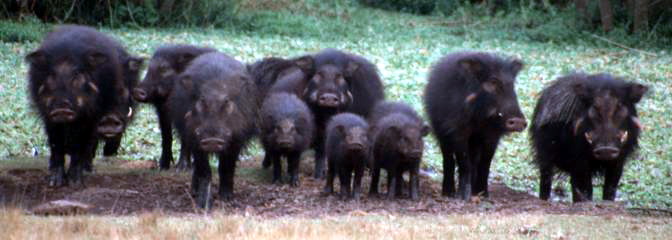|
| 질의: the snout | 결과: 281번째/526 | |
Giant Forest Hog (Hylochoerus meinertzhageni) - Wiki
| 제목: | Giant Forest Hog (Hylochoerus meinertzhageni) - Wiki
| |

| 해상도: 672x240
파일크기: 49059 Bytes
촬영일: 2007:09:16 17:29:10
등록시간: 2007:09:16 17:33:09
|
Giant forest hog
From Wikipedia, the free encyclopedia
[Photo] Giant Forest Hogs (Hylochoerus meinertzhageni). Date 13-Aug-2006. Author S. Fimpel (sasca@wildtierbiologie.de)
The Giant Forest Hog (Hylochoerus meinertzhageni) is the largest wild member of the pig family Suidae. It is the only member of the genus Hylochoerus. Males can reach as much as 2 metres in length and 1.1 metres high at the shoulder and have been known to weigh as much as 1,100 pounds (500 kg). Unlike most species of wild suid, the giant forest hog has extensive hairs on its body, though these tend to become less pronounced as the animal ages. It is mostly black in colour on the surface, though hairs nearest the skin of the animal are a deep orange colour. Its ears are large and pointy, and its tusks are much smaller than those of the warthog or bushpig.
Giant forest hogs occurs in the Jungles of West and Central Africa, extending also into the mountain forests of the Rwenzori Mountains and as far east as Mount Kenya and the Ethiopian Highlands. More truly herbivourous than any other wild suid or tayassuid, the giant forest hog feed chiefly on grass and other plant material and does not dig for food with its snout like other wild pigs do.
Giant forest hogs are nocturnal, being mainly active for about four to eight hours a day between dusk and dawn. They live in large herds (sounders) of up to twenty animals. However, breeding pairs leave a sounder completely and do not tolerate other individuals. This means that giant forest hogs cannot be domesticated, since this requirement for large breeding territories precludes them being kept in enclosures. They are, though, much more docile than other African suids.
Though known to native peoples of tropical African forests for many millennia and subject in many of these cultures to various taboos and superstitions, giant forest hogs were not scientifically classified until 1904.
http://en.wikipedia.org/wiki/Giant_forest_hog
| The text in this page is based on the copyrighted Wikipedia article shown in above URL. It is used under the GNU Free Documentation License. You may redistribute it, verbatim or modified, providing that you comply with the terms of the GFDL. |
|
^o^
동물그림창고 똑똑전화 누리집
^o^
|
|